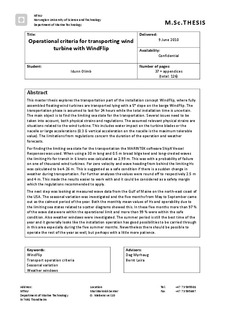Operational criteria for transporting wind turbine with WindFlip
Master thesis
Permanent lenke
http://hdl.handle.net/11250/237809Utgivelsesdato
2010Metadata
Vis full innførselSamlinger
- Institutt for marin teknikk [3397]
Sammendrag
This master thesis explores the transportation part of the installation concept WindFlip, where fully assembled floating wind turbines are transported lying with a 5° slope on the barge WindFlip. The transportation phase is assumed to last for 24 hours while the total installation time is uncertain. The main object is to find the limiting sea state for the transportation. Several issues need to be taken into account, both physical strains and regulations. The assumed relevant physical strains are situations related to the wind turbine. This includes water impact on the turbine blades or the nacelle or large accelerations (0.3 G vertical acceleration on the nacelle is the maximum tolerable value). The limitations from regulations concern the duration of the operation and weather forecasts.
For finding the limiting sea state for the transportation the MARINTEK software ShipX Vessel Responses was used. When using a 30 m long and 0.5 m broad bilge keel and long-crested waves the limiting Hs for transit in 6 knots was calculated as 2.99 m. This was with a probability of failure on one of thousand wind turbines. For zero velocity and wave heading from behind the limiting Hs was calculated to be 4.26 m. This is suggested as a safe condition if there is a sudden change in weather during transportation. For further analyses the values were round off to respectively 2.5 m and 4 m. This made the results easier to work with and it could be considered as a safety margin which the regulations recommended to apply.
The next step was looking at measured wave data from the Gulf of Maine on the north-east coast of the USA. The seasonal variation was investigated and the five months from May to September came out as the calmest period of the year. Both the monthly mean values of Hs and operability due to the limiting sea states related to scatter diagrams showed this. In these five months more than 97 % of the wave data were within the operational limit and more than 99 % were within the safe condition. Also weather windows were investigated. The summer period is still the best time of the year and it generally looks like the installation operation has good possibilities to be carried through in this area especially during the five summer months. Nevertheless there should be possible to operate the rest of the year as well, but perhaps with a little more patience.
